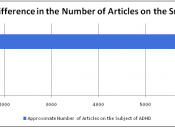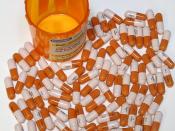Chris Brown
English 102: section 6
May 3, 1996
ATTENTION DEFICIT DISORDER
Approximately 3-5% of all American children have an
Attention Deficit Disorder (ADD). ADD is a leading cause of
school failure and under-achievement. ADD characteristics often
arise in early childhood. As many as 50% of children with ADD
are never diagnosed. Boys significantly outnumber girls, though
girls are more likely to be undiagnosed with ADD. 'ADD is not
an attention disorder, but a disorder of impulse control ( Seminar
notes Barkeley) .'
Characteristics of Attention Deficit Disorder can include :
Fidgeting with hands or feet , difficulty remaining seated,
awaiting turns in games, following through on instructions ,
shifting from one uncompleted task to another, difficulty playing
quietly, interrupting conversations and intruding into other
children's games, appearing to be not listening to what is being
said, doing things that are dangerous without thinking about the
consequences.
Most scientist now believe that a brain dysfunction or
abnormality in brain chemistry could be to blame for the
symptoms of Attention Deficit Disorder. The frontal lobes of the
brain are thought to be most responsible for the regulation of
behavior and attention. They receive information from the lower
brain, which regulated arousal and screens incoming messages
from within and outside of the body. The limbic system , a group
of related nervous system structures located in the midbrain and
linked to emotions and feelings, also sends messages to the frontal
lobes. Finally, the frontal lobes are suspected to be the site of
working memory, the place where information about the
immediate environment is considered for memory storage,
planning, and future-directed behavior. Scientist believe the
activity in the frontal lobes is depressed in people with ADD.
Studies show a decrease in the ability of the ADD brain to use
glucose, the body's...



Nice paper
This is a good paper. It is sited. It has some valuable information. I hope it helps with your brother.
1 out of 1 people found this comment useful.